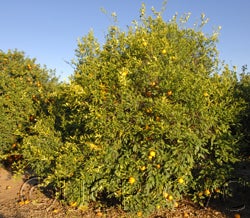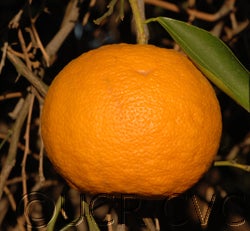Citrus taiwanica Tan. & Shimada
CRC 2588
PI 539680
Source
Received as budwood and grown as a cutting via W.T. Swingle, USDA, Washington DC, 1935.
Parentage/origins
Parents unknown.
Rootstocks of accession
Carrizo citrange, C-35 citrange
Season of ripeness at Riverside
January to March
Notes and observations
2/26/1988, EMN: About half of crop is on the ground. Fruit about grapefruit sized. Rind dark yellow, moderately rough & pebbled; oblate shaped. Rind moderately thick; seedy. Flesh lemon yellow to light orange/ yellow, juicy, sour.
2/11/2008, TS & DK: Slightly necked, yellowish fruit, very sour and bitter; very few fruits left on tree, and not that many under it Noelle Barkley et al., “Assessing genetic diversity…”, Theor Appl Genet (2006) 112: 1519–1531: Bar graph on p. 325 shows that Nansho Daidai is of about 60% pummelo, and 40% mandarin--more mandarin than is indicated for most other sour orange accessions.
Description from The Citrus Industry Vol. 1 (1967)
"Fruit medium-large, obovate; broadly necked and narrowly collared; seedy. Rind medium-thick but easily peeled; somewhat pebbled; prominent sunken oil glands; color lemon-yellow. Sections 10 to 12 and axis open. Flesh color dull yellow; juicy; acid flavor with bitter aftertaste. Seeds large, slimy, with wrinkled seed coat, and polyembryonic.
Tree vigorous, upright-spreading, and very thorny. Foliage consists of medium-large, somewhat slender, light green, sharp-pointed, strongly winged leaves, the oil of which is suggestive of bitter orange.
Thought to have originated in the Nanshô district of Taiwan (Formosa), where it has no economic importance, the Nanshôdaidai is included here because of its promise as a substitute for sour orange rootstock in California."
Availability
Not commercially available in California.
USDA Germplasm Resources Information Network page for Nansho Daidai sour orange


